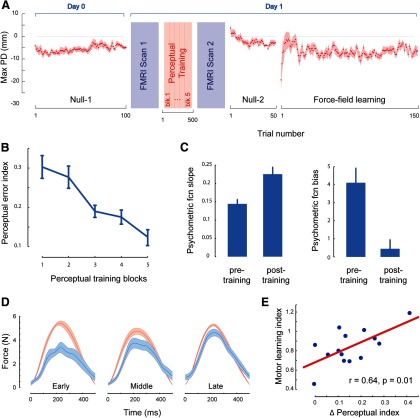Figure 1.
Somatosensory perceptual learning benefits both perceptual and motor behaviors. A, Experimental sequence, fMRI scanning sessions, and average lateral movement deviation in different phases of the experiment. Shaded area shows SEM. B, The PI improves over the course of somatosensory training (mean over subjects ± SEM). Lower PI values indicate decreased perceptual classification error. C, The perceptual boundary (psychometric function bias, right) and acuity (psychometric function slope, left) change over the course of somatosensory training. Bar plots show the average performance in the first (block 1) and final (block 5) blocks of perceptual training (mean over subjects ± SE). D, Motor learning as reflected in lateral force production in channel trials early, midway, and late in force-field learning. Lateral applied force profiles are shown in blue averaged across subjects. The red curves show the ideal force profile that subjects would need to exert to fully compensate for the force-field perturbation. E, Subjects who learned more during perceptual training (as measured by ΔPI) subsequently exhibited greater amounts of motor learning (as measured by FI). Each point represents one subject.

